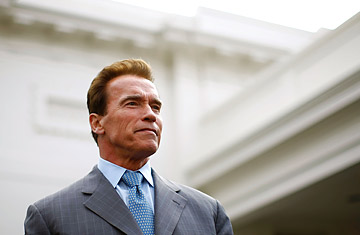
California Governor Arnold Schwarzenegger
California is a state in crisis. Negotiations to resolve its $26.3 billion budget deficit are weeks behind deadline, more than $470 million worth of IOUs are clogging government ledgers and its state bonds are trading at near junk status. It's been a long, slow tumble from the Golden State's glamorous peak in the 1960s--when Governor Pat Brown built an efficient network of freeways and thriving, affordable public universities--to today's insolvent government beset by an unwieldy constitution and decades of mistakes.
California's crisis winds all the way back to 1978's Proposition 13, which cut property-tax rates 57% and forced the state to rely more heavily on income tax revenue. When Californians were wealthy, the tactic generated a surplus, enabling politicians to cut taxes, pad budgets and bask in their popularity. But when times were lean, the state struggled to pay its bills. Governor Pete Wilson encountered this dilemma in 1991, as did Gray Davis in 2003. Now it's Arnold Schwarzenegger's turn to try to wrestle a highly partisan legislature into slashing enough programs to eliminate a towering deficit. Having raised taxes by $12.8 billion in February, the governor balked at a second hike.
California's system of governance seems designed to thwart any solution its lawmakers propose. With a two-thirds majority required to raise taxes or pass a budget, 40% of public funds earmarked for public schools and no method of overriding voter initiatives, California seems stymied by a complex puzzle that no one can solve.
2/3 Dangers of Direct Democracy
California employs a unique combination of representative and direct democracy. A 1933 provision requires a two-thirds majority in both houses to pass a budget, a rule shared only by Rhode Island and Arkansas. Tax increases must pass by the same percentage--a stipulation adopted by just 12 other states. California also uses referendums, recalls and voter initiatives more frequently than any other state. This tangled structure often combines to confound legislators seeking changes that would relieve the state's woes.
12 Referendums and initiatives on California's 2008 election ballot
0 Other states requiring a two-thirds majority to change both taxes and budgets
[The following text appears within a chart. Please see hardcopy or PDF for actual chart.]
State Budget Deficits Seven U.S. states still haven't solved their budget gaps
Percentage of overall budget
California 28%
Illinois 33
Pennsylvania 18
North Carolina 22
Connecticut 23
Arizona 41
Michigan 12
Largest state deficits, in billions of dollars
Center on Budget and Policy Priorities
Scaling Back Costs
Road to Insolvency
Unlucky 13 1978 Proposition 13 caps property taxes at 1% of a home's value, forcing the state to rely heavily on more volatile capital gains and income taxes for revenue
That'll Teach 'Em 1988 Proposition 98 allocates roughly 40% of the state budget to education
In Debt 1991 Governor Pete Wilson, who inherited a $14 billion deficit, raises taxes by $7 billion
Rolling in Dough 1998 California records a $4 billion surplus. State leaders agree on a $1.4 billion tax cut
